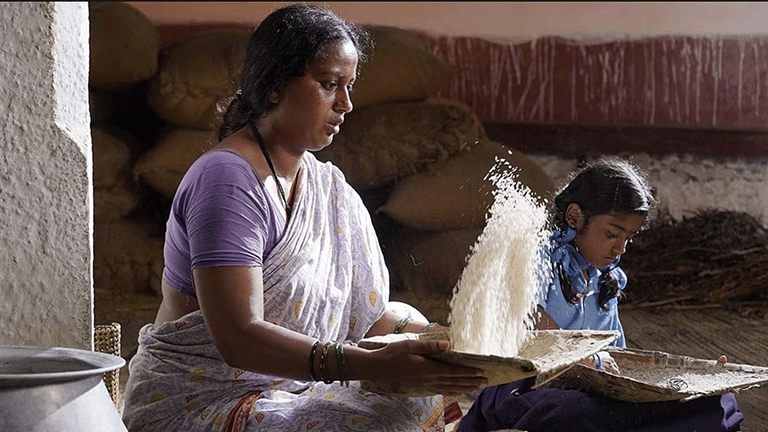In Champa P Shetty’s latest film, Huchheeri’s seemingly simple goal of preparing chicken curry or Koli Esru for her daughter Lakshmuu becomes a formidable challenge. This event not only becomes a turning point in her life, liberating her from the struggles of daily life marked by grief, disparagement, and discrimination.
Huchheeri, portrayed by Akshatha Pandavapura, is the resilient, caring, and street-smart protagonist in “Koli Esru.” Despite having a husband, she navigates life in her small village almost like a single mother, engaging in various odd jobs from sweeping floors to cleaning rice.
In one early scene, she finds her intoxicated husband on the street near their home and carries him back. Moments before, she had to fend off the persistent Gende Kala, a beedi-smoking individual who had been ogling her. Huccheeri lives on constant alert, not only because she is a woman but also due to her position at the bottom of the village’s caste hierarchy.
Interestingly, the term ‘caste’ is never explicitly mentioned in Shetty’s film, yet its impact is strongly felt through Huchheeri’s perpetual presence in the shadows. For instance, when attending a feast at a dominant-caste home, she is forced to speak to the hosts from the rear entrance, away from the festivities.
When asked about the role of caste in the narrative, Shetty mentions that while it may not be a prominent subject in the film, it is an inherent part of the narrative and the world it portrays. She recalls a scene involving child artists from lower castes being denied entry to an upper-caste house, leading her to omit the scene instead of replacing the chosen cast.
Despite the hardships, Huchheeri’s world revolves around her young daughter Lakshmuu. The child, eager to study further, faces resistance from her illiterate mother, who sees more value in her assistance with household chores. However, Huchheeri accurately recognizes her daughter’s deep love for Koli Esru. The dish, representing the mother’s hope and desire for her child’s joy, becomes a metaphor for the lengths she is willing to go.
In KT Chikkanna’s short story “Huchheeri Esarina Prasanga,” the focus is on the impoverished life of the mother and daughter, centered around their love for Koli Esru. Shetty enriches the film with layers and authenticity, transporting viewers to an unnamed yet familiar Indian village.
The authenticity extends beyond the characters’ language to the portrayal of life in the village. Non-professional actors dominate the ensemble, capturing the essence of the region. The use of sync sound, particularly folk songs from small temples, adds to the rustic flavor. Shetty’s cinematography choice, characterized by stillness, resonates with the reality of the setting.
Akshatha Pandavpura’s outstanding performance as Huchheeri is a highlight. Balancing vulnerability and stoicism, she captivates with expressive eyes and a compelling gait. The supporting cast, including Natana Manju, Prakash Shetty, and non-professional actors, complements the narrative seamlessly.
Shetty emphasizes the importance of using local theatre artists with a natural flair for the dialect spoken in the film. Akshatha Pandavpura’s casting, based on her memorable performance in Bigg Boss Kannada, aligns with Shetty’s vision.
While some might perceive a lack of ambition in certain narrative aspects, Shetty is confident that she has realized her envisioned film. Despite potential alternative directions, she asserts that the final outcome captures her pursuit as a writer-director—a story filled with love, hope, and resilience.



